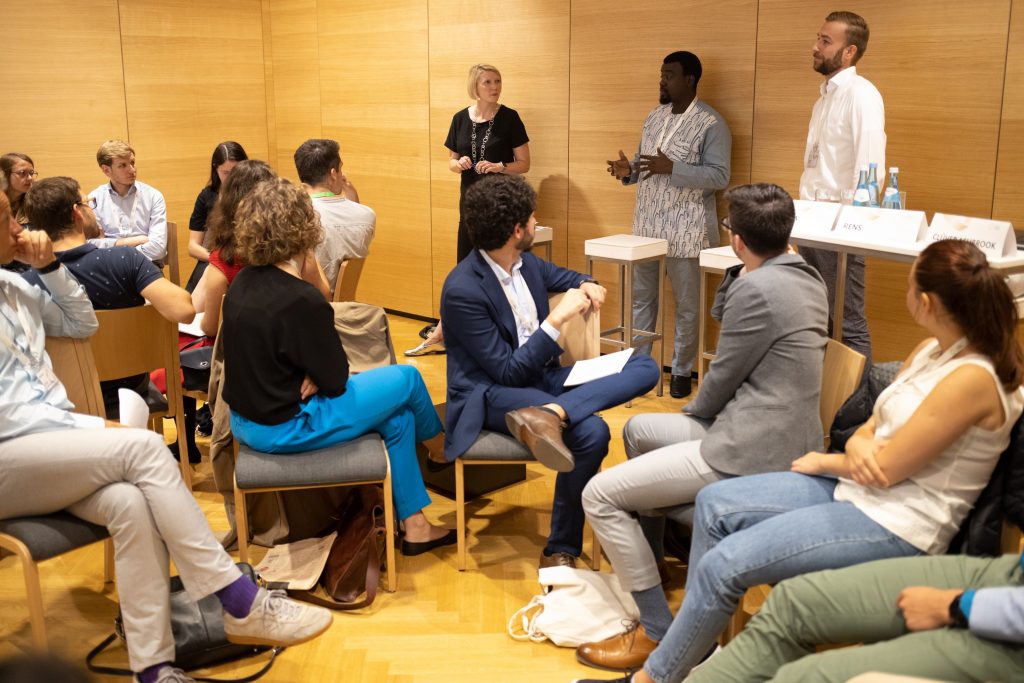KHOÁ IELTS Intermediate 2
Chương trình luyện thi IELTS cam kết đầu ra
Khóa IELTS Intermediate 2 thuộc Chuơng trình luyện thi IELTS cam kết đầu ra của YOURE được phát triển dựa trên lộ trình cá nhân hoá học tập nhằm giúp từng học viên theo cách tối ưu nhất. Với cổng học tập nội bộ learn.youre.vn, được cập nhật xuyên suốt trong chương trình học dựa theo tình hình gửi bài tập của học viên, đội ngũ giảng viên YOURE sẽ chấm và chữa bài chi tiết, đúng thời hạn, nhằm giúp học viên có thêm nhiều thời gian luyện tập ngoài giờ học.
Khóa IELTS Intermediate 2 dành cho các học viên ở trình độ đầu trung cấp (B1) để thúc đẩy và hoàn thiện bộ kỹ năng giao tiếp và năng lực ngôn ngữ tại cấp độ cao trung cấp (B2). Với đặc trưng dài hơn của chặng đường trung cấp, học viên sẽ được xếp vào 1 trong 2 cấp độ.
Sau khóa học, học viên có thể nắm bắt được nội dung của các văn bản có tính chuyên sâu hơn và trình bày được ở nhiều mức độ lưu loát và rõ ràng về nhiều nội dung từ thân thuộc đến trừu tượng hơn. Học viên có thể dùng tiếng Anh để thể hiện các kĩ năng ở tư duy bậc cao như so sánh, tương quan thông tin. Học viên trong khóa học này có bộ kỹ năng và năng lực ngôn ngữ hoàn thiện hơn Level Intermediate 1.
- Học phí: 9.600.000 đồng
- 72 giờ học với giáo viên,trợ giảng
- 144 giờ tự học

Thông tin cơ bản
KHOÁ IELTS INTERMEDIATE 2
Chương trình luyện thi ielts cam kết đầu ra
Thời lượng: 12 tuần
Thời gian: 3 buổi/ tuần; 120 phút/ buổi
Học phí: 9 triệu 600 nghìn
Sỉ số 1 lớp học: 6 học viên/ tối đa 8 học viên
Learning Modules
IELTS Intermediate 2
Chủ đề 1
THE MAN-MADE ENVIRONMENT
Chủ đề 2
LEISURE & EDUCATION
KIỂM TRA GIỮA CẤP ĐỘ
LẦN 1
Chủ đề 3
THE NEWS & MEDIA
Chủ đề 4
TRAVEL & TRANSPORT
KIỂM TRA GIỮA CẤP ĐỘ
LẦN 2
Chủ đề 5
BUSINESS & WORK
Chủ đề 6
THE NATURAL ENVIRONMENT
KIỂM TRA GIỮA CẤP ĐỘ
LẦN 3
Chủ đề 7
EDUCATION SYSTEMS
Chủ đề 8
FESTIVALS & TRADITIONS
KIỂM TRA CUỐI CẤP ĐỘ

The man-made environment
Reading
– Skimm a text quickly to understand the general idea
– Scan a text for specific information to answer short-answer questions
– Use skimming and scanning to locate the answer quickly
– Understand and produce paraphrasing
– Use the present continuous and present simple correctly
Writing
– Select key features of different types of graph, chart, and table in order to describe them accurately
– Use suitable verbs, adjectives, and adverbs to describe trends in different ways
– Compare different graphs or information in the same graph and write a summary of the main features
Listening
– Predict the type of information required for short-answer questions
– Listen for specific information (e.g. complex numbers, difficult spellings) and write it down correctly
– Listen to understand context
– Answer multiple-choice questions correctly by eliminating distractors
Speaking
– Speak about various aspects of where you live for: Speaking part 1
– Respond to wh-, would and Yes/No questions about where you live
– Prepare more information for common Speaking part 1 topics
– Use syllable stress in words correctly

leisure & education
Reading
– Identify questions that ask for factual information and questions which ask for the writer’s opinion
– Skim and scan to arrive at the correct answers quickly
– Understand the whole text to answer questions about global understanding
– Use the past simple and past continuous correctly
Writing
– Select and compare ket features of charts, graphs, and tables
– Structure an answer which compares information from charts, graphs, and tables
– Revise the form and use of comparatives
Listening
– Listen to and understand directions from one place to another
– Match descriptions with people, places, or things
– Listen for specific information and classify it in a table
Speaking
– Express your opinions about sport for Speaking part 1 and 2
– Use connecting words to give longer and more detailed answers
– Use sentences stress and intonation to express your feelings about a topic

the news & media
Reading
– Match information in a question with information in a text
– Skim a text to identify types of information
– Recognise the passive
Writing
– Use time markers and the passive to describe the process
– Plan a description of a process
– Interpret scientific and technical diagrams
Listening
– Identify the attitudes and opinions of speakers through expressions and intonation
– Recognise paraphrases of what speakers say
– Understand the role of distractors when answering multiple-choice questions
Speaking
– Speak about the news and media for Speaking part 1
– Use adjectives and intonation to express feeling about a news story
– Use paraphrase and the passive to describe an event for Speaking part 2

travel & transport
Reading
– Understand the main ideas paragraphs in order to match headings to sections of text
– Use the past simple, past perfect simple, and past perfect continuous correctly
– Recognise synonyms in texts and headings
Writing
– Study and compare two maps
– Read your writing to check for spelling and grammatical errors
– Improve the cohesion of your writing by organising your ideas in a logical way
– Make your writing easier to understand by using cohesive devices
Listening
– Identify the main subject of conversations
– Identify the functions that speakers are
– Match questions and options (e.g. solutions to advantages/ disadvantages)
Speaking
– Plan your long-turn answer for Speaking part 2
– Use the correct sequencing words to give your answer a clear structure
– Understand sentence stress when using sequencing words
– Deal with follow-up questions after your long turn

business & work
Reading
– Skim a text to identify facts, opinions, and theories
– Match a fact, opinion, or theory with a person
– Recognise the use of will and going to future forms
– Match sentence beginnings and endings about a passage
Writing
– Analyse an “advantages and disadvantages” essay task
– Plan your ideas and organize them into paragraphs
– Use linkers to make your essay easy to read
Listening
– Use notes to follow a talk or lecture
– Identify information needed to complete notes or sentences
– Recognise the language of comparison and contrast to predict ideas in a talk
Speaking
– Speak in detail about business and work for Speaking part 2
– Express your wishes and intentions in variety of ways
– Expand your answer to a Speaking part 2 task using subordinate clauses
– Use contractions when speaking to sound more natural

the natural environment
Reading
– Approach Yes/No/Not Given questions
– Identify whether statements in questions match the writer’s views
– Use so, too, either and neither to agree or disagree with someone
– Complete a summary with words from a box or words from a passage
Writing
– Avoid writing irrelevant ideas in an “agree or disagree” essay
– Express your ideas clearly in an essay
– Write in an appropriate neutral/ formal style
– Avoid repeating words and phrases
Listening
– Complete a diagram showing a process
– Answer multiple-choice questions
– Understand the use of signposting words
– Revise quantifiers with countable and uncountable nouns
Speaking
– Speak in detail about conversation and the environment
– Recognise different functions in Speaking part 3 questions
– Express your opinions with the appropriate emotion

education systems
Reading
– Skim a text to locate information quickly
– Understand a text in order to label a flow-chart, diagram, or technical drawing
– Use modals of obligation (should, have to, and must) correctly.
Writing
– Generate ideas about a topic and express your opinion clearly
– Organise your essay in a logical order
– Proofread your writing effectively
Listening
– Listen to and understand a description
– Complete a chart, diagram, or sentences based on a talk or dialogue
– Use notes to follow what a speaker is saying
Speaking
– Speak in detail about the education
– Consider reasons, causes, and effects for different Speaking part 3 situations
– Make suggestions or recommendations

festivals & traditions
Reading
– Find factual information in a text to decide if a statement is True, False, or Not Given
– Practise identifying Not Given questions
– Recognise and use the first and second conditional correctly
Writing
– Identifying and approach a “problems and solutions” essay question
– Plan and write an essay answering both parts of the question
– Write a suitable introduction and conclusion
– Revise past, present, and future tenses
Listening
– Identify key information in summaries and tables to guide your listening
– Classify information as you listen
– Listen carefully to complete summaries and tables
Speaking
– Speak in detail about celebration and special events
– Make comparisons between the past and the present, or between similarities and differences
– Use words and phrases that show “concession” to look at both sides of an argument
– Stress keywords to make comparisons






